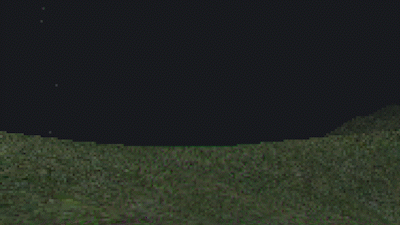
During a reconnaissance flight over the British archipelago, a fighter pilot is forced to eject after losing control of his aircraft. Stranded on a remote island, he discovers remnants of an abandoned settlement.
Concept
Warlock is a 90s style walking simulator with a focus on immersion and story. It explores themes such as isolation, fear of the unknown and humanity’s place in the universe.
Game Design Document
Working title
Warlock
Concept statement
Warlock is a 90s-style walking simulator with a focus on immersion and story. It explores key themes such as isolation, fear of the unknown and humanity’s place in the universe.
Genre
Walking simulator
Target audience
Adults 30+ that enjoy walking simulators, the 90s/PSX art aesthetics, exploration and puzzle solving.
Unique selling points
The 90s aesthetics not only helps the game stand out visually, it also lowers the game’s hardware requirements and size which will allow the game to be played on most hardware and platforms (mobile, web browser, etc.).
The minimal game mechanics will also attract players with less gaming experience.
Player experience
The player is a military pilot who ejects during an unexplained incident and reaches a strange, uninhabited island. The landscape is harsh. As he explores, he is drawn toward a silent alien ship hovering above the island.
The game offers the fantasy of being part of a hidden event beyond human understanding. It evokes tension, curiosity, and isolation, keeping the player engaged through atmosphere and the drive to uncover what lies at the end.
Visual style
The game adopts a 90s-style aesthetic, using low-poly geometry and low-resolution textures combined with limited draw distance and screen-space fog. Real-time lighting is disabled and shadowing is simulated through vertex color baking.
The result is a stylized, retro 3D look reminiscent of early console-era rendering techniques.
Audio design
The audio design channels a PSX-era aesthetic with controlled lo-fi elements that still preserve clarity and immersion.
Sound effects are slightly compressed and distorted to match the visual tone, while ambient electronic music underscores the experience with a subtle, moody presence.
Environmental audio is bold and expressive, to help build tension, and intensify the player’s sense of isolation within the world.
Game world fiction
A military pilot ejects from his aircraft during an unknown incident and lands in the ocean. He swims to a nearby island during a storm.
He follows a path inland through fog-covered cliffs. As he explores, he discovers large stone structures arranged in circular patterns. Strange sounds come from the sky. During a lightning strike, he briefly sees a massive alien ship above the center of the island.
The island appears uninhabited, but its structures show signs of recent activity. The ship does not move, but it waits. It has been sent to retrieve a human.
Monetization
One-time purchase
Platform
All major platforms, including mobile and browser.
Core loop
Observe -> Interpret -> Move -> Observe
Objective and progression
The player’s implicit goal is to follow environmental cues and emotional tension to discover what’s behind the crash, the structures, and the massive alien ship.
There is no quest log or objective marker, only curiosity and emotion.
Game systems
Player movement, audio, environmental zones, triggers
Prototype
To help structure the emotional flow and overall experience of the game, I divided the prototype’s progression into distinct narrative beats.
Each beat represents a shift in atmosphere, pacing, or focus to keep the experience engaging without relying on traditional gameplay mechanics like dialogue, combat, or objectives.
The breakdown below outlines these beats and highlights the design thinking behind each one.
1. Drift (Start)
The game begins with the player floating in the ocean. The screen fades in from black. There’s no UI, no music—only the sound of rain, wind, waves, and distant thunder.
This moment establishes vulnerability and sets the tone for the rest of the experience. The ocean is vast, dark, and impersonal. The player’s only goal—though never explicitly stated—is to swim toward the distant shoreline.
Design focus:
Use of environmental audio to create immersion
No player guidance—encouraging instinctive exploration
Establishing mood before control or clarity
2. Arrival
Once the player reaches the beach, the environment subtly shifts. A narrow path is visible between the cliffs, offering a sense of direction and protection from the wind. Fog thickens, and ambient music begins—serving as a cue that the player is progressing correctly.
Design focus:
Introducing visual and auditory cues to guide the player without explicit instruction
Using environmental transitions to mark emotional shift from vulnerability to curiosity
Music placement as a reward and pacing tool
3. Discovery
The path leads to a second beach. From here, smoke is visible rising behind a cliff. Following the smoke leads to a crashed fighter jet—burning softly, crackling with residual heat and static.
This moment grounds the player’s experience. It adds context to who they might be and raises questions about the world they’ve entered.
Design focus:
Use of a striking setpiece to reorient the player and deliver visual storytelling
Environmental sound reinforces realism and narrative weight
Smoke as a natural visual lure
4. Direction
As the player moves higher into the island, a thunderclap reveals a massive alien spacecraft above the mountain—only visible for a moment during a lightning strike.
This beat introduces scale and mystery. The reveal is timed to surprise the player and shift the tone from grounded to otherworldly.
Design focus:
Use of weather and lighting to time a dramatic reveal
Visual layering: showing the player something large and distant to instill curiosity
Establishing stakes and wonder without exposition
5. Tension
The path narrows into a long, dark tunnel. There’s no light ahead—only shadow. The sound fades. For a moment, it feels like the world is holding its breath.
This moment is designed to slow the player down. Visibility is limited, and the atmosphere shifts from eerie to oppressive. There are no enemies, no jump scares—just silence, darkness, and the feeling that something could be waiting.
Design focus:
Using darkness and silence to create psychological tension
Pacing the player through environment, not mechanics
Building emotional contrast before the visual climax
6. Confrontation
The path ends beneath the massive alien spacecraft. It hovers in silence, unmoving—impossible in size, geometric in design.
Then, a beam of light shoots down to the ground.
The player can choose to walk into it. When they do, they are lifted into the air. There is no struggle, no resistance—just ascent. The screen fades to white.
Design focus:
Culmination of the journey through visual and emotional scale
No dialogue or payoff explanation—meaning is left to the player
Using motion (vertical lift) and fade-out to suggest closure and transformation









